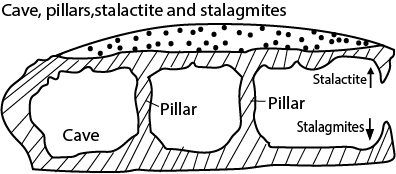
Describe the landforms resulting from chemical weathering in East

Candidates should define chemical weathering as the decomposition/decay/rotting of rocks at or near the earth surface. It occurs in situ (one place).
Candidates should identify conditions favouring chemical weathering. These include:
- Heavy rainfall and high humidity to avail water to act as a medium of chemical reactions.
- Hot temperatures to accelerate the rate of chemical reactions.
- Presence of atmospheric gases like oxygen, carbon dioxide and mineral compounds.
Candidates should identify areas where chemical weathering is common. e.g.
- Lake Victoria basin like Jinja, Mwanz.a, Kisumu.
- Nyakasura area in Western Uganda.
- East African coast e.g. Mombasa. Dar es Salaam.
Candidates should describe land forms due to chemical weathering in East Africa.
NB; – Candidates should bring out processes of chemical weathering like carbonation, solution, Oxidation but these processes may be integrated with explanation of landforms
Candidates may bring out illustrations and local examples
Stalactite and stalagmite
These are formed through carbonation. Rain water combines with carbon dioxide in the atmosphere to form weak carbonic acid which dissolves calcium carbonate to form calcium bi carbonate. When solution reaches underground cave, calcium carbonate is deposited on roof of the cave to form stalagmite e.g. at Nyakasura in Western Uganda.
Pillars.
These are vertical stands of calcium carbonate formed in underground caves when stalactites and stalagmites continue to grow towards each other and eventually join. Examples arc found at Nyakasura and Tanga.
Caves: a cave is a natural underground space. It is formed when there is chemical dissolution of limestone or dolomite. The rock is dissolved by natural acid in ground water that seeps through the bedding planes, faults and joints.

Grikes and Clints
Grikes are hollows or depressions while Clints are ridges formed as a result of carbonation. They formed in limestone areas with rocks of different chemical composition. Lime stone is dissolved by acidic rain to form depressions/ hollows called Grikes while dissolved rocks form ridges called Clints/ Limestone pavement.

Sink/roles
A sinkhole is a natural depression or hole in earth’s surface formed when lime stone is dissolved. It is formed through the processes of removal of soluble rock by percolating water and the collapse of roof cave.
Dolines: these are larger than sinkholes. These are shallow circular depressions formed either by solution of the surface lime stone or by collapse of underlying caves. In latter case they are called collapse doline.
Polje. This is an elongated basin having a flat floor and steep walls. The poljes are formed by coalescence of several sinkholes when being formed through carbonation and solution. In some poljes, small residual hills known as hums are formed.
Limestone gorge is deep steep-sided valley formed when acid rain seeps into the cracks in limestone rocks or when a larger river erodes/ weathers soft limestone rocks by solution.
Duricrust is a hard crust (layer) found on the surface formed from mineral precipitation i.e. deposition of insoluble materials from a solution. The most common in East Africa is lateritic duricrust formed when the weathered layer become impregnated with iron solution due to leaching. On removal of top layer laterite hardens into duricrust like on flat topped hills of Buganda/ laterite terms·
Tors are landforms created by chemical weathering of a rock along along joints followed by removal of the weathered material

I do enjoy digital teachers so much
I can’t wait to share this with my friends. Computer & Accessories
I’m excited for what you’ll share next. TamilBlasters Com
Experience a hassle-free enrollment process with MBBS Direct Admission in Karnataka.
Learn about competitive entry scores for MBBS Cutoff Of Government Medical Colleges in West Bengal.
Install the Raja Luck App and explore exciting gaming options.